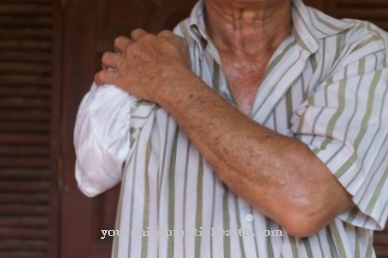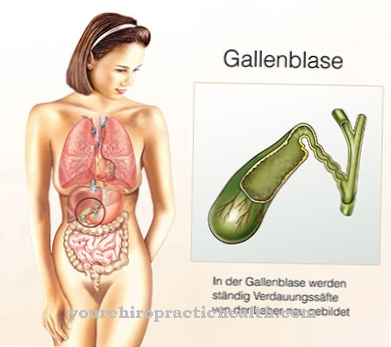A Rupture of the posterior cruciate ligament is an accident injury. It occurs relatively rarely and is often recognized late. A precise diagnosis is therefore important in order to avoid consequential damage.
What is a posterior cruciate ligament tear?

© toricheks - stock.adobe.com
The posterior cruciate ligament is the thickest and most important ligament in the knee joint. It ensures that the lower leg does not slip behind the thigh bone at the base of the knee joint.
A posterior cruciate ligament tear is much less common than an anterior cruciate ligament tear due to the position and thickness of the ligament. Because a lot of force is required for this injury, a rupture of the posterior cruciate ligament rarely occurs in isolation.
It is usually accompanied by further injuries to the knee, so it can easily be overlooked and then left untreated. In this case, the originally acute injury can take on a chronic form. This can cause consequential damage.
causes
Tears in the posterior cruciate ligament occur when the greatest possible elongation of the ligament is exceeded. This often happens with so-called rapid trauma, meaning injuries in which a sudden strong force acts on the knee.
This can happen in motorcycle, bicycle or car accidents. It is known from car accidents that when the knee hits the dashboard, the lower leg is pushed backwards, which can cause a tear in the posterior cruciate ligament. However, this is an increasingly rare cause of injury.
Far more common is a posterior cruciate ligament tear as a result of a sports injury, such as a fall on the bent knee or an impact trauma from an opponent, as is more common in American football, for example. This often leads to further injuries to the knee at the joint capsule or other ligaments.
Symptoms, ailments & signs
A posterior cruciate ligament tear sometimes manifests itself as a distinct cracking or tearing. Patients often feel a feeling of displacement in the knee, accompanied by an unusual feeling of pressure. This is followed by severe pain, which however subsides after a few minutes. In the further course, the pain mainly occurs when the affected leg is loaded.
The symptoms are usually greatest when climbing stairs or squats, which is why those affected usually adopt the typical, slightly bent position with their knees. The knee swells, which can lead to restricted mobility. The injury to blood vessels results in a bruise in the area of the joint, which, however, quickly subsides.
In the first few days after the injury, the knee feels unstable and can no longer be moved as before. A cruciate ligament tear is not always noticed immediately by those affected. Sometimes the injury only manifests itself through increasing gait uncertainty and pulling in the knee. In addition, the knee bends away even when the load is low. In general, a posterior cruciate ligament tear causes generalized knee pain that, depending on the severity of the injury, can extend to the upper and lower legs or even to the foot.
Diagnosis & course

Since a rupture of the posterior cruciate ligament is comparatively rare and is usually associated with numerous accompanying injuries due to the force required for it, it is easily overlooked.
For this reason, a particularly thorough diagnosis is important for knee injuries. The affected knee is usually swollen and unspecifically painful. Bruising may be visible. A description of the course of the accident gives first indications of the extent and type of damage to the knee, and a careful examination of the knee joint with special tests is essential. Concomitant injuries to the inner and outer ligament should be checked, including cruciate ligament injuries and tears in the inner or outer ligaments.
The so-called rear drawer is checked, while the lower leg is pushed back against the thigh. X-ray examinations and magnetic resonance imaging (MRI) are also part of the diagnosis. In order to measure the extent of the drawer movement of the lower leg, functional x-ray images, so-called held images with the help of an apparatus provided for this purpose, can be useful.
However, even with an MRI, a tear in the posterior cruciate ligament can be difficult to detect, since the ligament is relatively well supplied with blood. An injured ligament can also heal on its own, but then usually remains lengthened. The resulting instability of the knee can become chronic in this way. Cartilage damage occurs as a result of the incorrect sequence of movements, which can lead to osteoarthritis in the knee within a few years.
Complications
Unfortunately, in many cases the diagnosis of this injury is delayed, which is why a complete healing is often not possible. The cruciate ligament tear often causes severe pain in the knees. These pains not infrequently spread to other regions of the body and can also lead to sleep problems in the form of rest pain at night.
The knee is often swollen and affected by a bruise. Often the knee is also unstable, so that the patient can no longer easily perform heavy physical work or sports. The quality of life of the person affected is considerably reduced by the cruciate ligament tear. Uncertainties in gait continue to occur and the person concerned often takes a gentle position, which, however, has a negative effect on health.
The pain and restrictions can also lead to psychological complaints and possibly to depression. The treatment of this complaint is usually carried out through therapy or with the help of a surgical procedure. There are still no particular complications.
However, a positive course of the disease is not always possible, so that the person affected may suffer from limitations throughout their life. It may then no longer be possible to carry out certain sports. There is no reduced life expectancy.
When should you go to the doctor?
If there are sudden discomforts, a cracking noise and problems when moving, the leg should be immobilized. The complaints occur in the knee area and can occur during sporting activities as well as with everyday movements. A doctor is needed in the event of a cruciate ligament rupture, but the person affected can take a few supportive measures on site that have a positive influence on the further course.
If possible, the leg should no longer be loaded and should be cooled until the medical examination. In the event of swelling or discoloration of the skin, a medical clarification of the symptoms is necessary. The clothing on the knee must be removed so that there are no tightnesses or problems with blood circulation. If there is pain, unsteady gait or a loss of strength in the leg, there is cause for concern. In a euphoric mood, those affected often notice belatedly that a ligament has ruptured. You notice a shaky feeling during normal movements and should consult a doctor to check it.
In the event of sudden bruises, sensory disorders or abnormalities when touched, a doctor's visit is necessary. If the knee stiffens or if the knee joint is particularly unstable, a doctor is required. People with knee disease should be extra careful not to let time pass before treatment.
Doctors & therapists in your area
Treatment & Therapy
A tear of the posterior cruciate ligament is a relatively serious injury, but usually heals well with conservative measures. In the course of such a non-surgical treatment, the knee is first immobilized in a special splint or stabilized with a splint that allows restricted movement.
This prevents the lower leg from sliding back against the thigh at rest or when moving. This splint is usually worn for about six weeks. The supporting muscles, especially in the thighs, are strengthened through physiotherapy exercises. If the rest of the ligaments are also affected, surgery is recommended. Similar to the more common anterior cruciate ligament tear, the damaged posterior cruciate ligament is also replaced by the transplantation of an endogenous tendon. However, the procedure is more complicated than with an anterior cruciate ligament tear.
The success of the operation depends not least on how carefully the follow-up treatment is carried out in order to avoid consequential damage such as restricted mobility or osteoarthritis in the knee. After the operation, a stiffer splint must be worn for about six weeks, followed by a splint that allows initial movements. Accompanying lymphatic drainage is recommended; precisely coordinated physiotherapy is absolutely essential.
After a longer period of rest for recovery, movement exercises are only carried out passively in the first few weeks, later on the first load exercises are added, which are increased very slowly. If the therapy is successful, the injury is considered to have healed after about half a year. After about a year, the leg can be fully loaded again. The extent to which certain sports can then be carried out or are recommended must be decided on a case-by-case basis.
Outlook & forecast
The difficulty of the posterior cruciate ligament tear lies in the correct and rapid diagnosis. Often the tear is overlooked or the existing injury is misdiagnosed. This leads to a delay in the appropriate treatment and can cause complications or problems with healing. If the crack is documented in a comprehensive and thorough diagnosis shortly after the accident or fall, a complete recovery can be achieved with optimal medical care.
Normally, the patient gets a good prognosis, since the posterior cruciate ligament tear heals completely, taking into account a few guidelines. The healing process takes several weeks or months and is associated with immobilization of the knee joint. The sooner this happens and the less stress there is on the joint, the shorter the healing path. Restricting the movement of the knee is essential. Some patients require surgery. If this goes without any further complications, the patient can also be discharged from treatment after a few months as symptom-free.
In both cases, targeted training and exercise units should be used after wearing a splint for fixation. Your goal is to rebuild the existing muscles as quickly as possible. If medical care is denied, locomotion can be impaired for life.
prevention
A rupture of the posterior cruciate ligament can only be prevented by avoiding high-risk sports such as American football or hockey. Strengthening the muscles and regular strength training relieve the knee joint and can further reduce the risk of a posterior cruciate ligament tear.
Aftercare
As early as the conservative treatment or before the operation, the patient should begin independently with exercises to tighten the thigh muscle. The attending doctor or the physiotherapist will instruct the patient accordingly and go through the exercises in detail. However, when the posterior cruciate ligament is injured, follow-up care must be approached very moderately and gently compared to other ligament injuries.
After the operation, the patient receives a so-called PTS splint. This usually remains with the patient for six weeks. With the PTS splint, a pad on the lower legs ensures that it is pushed forward. This protects the posterior cruciate ligament replacement. In the first six weeks, exercises are only performed very passively and in the prone position.
The affected leg cannot be subjected to any load here. First, exercises are performed with a maximum weight of ten kilograms. After two weeks, the load weight can be increased to twenty kilograms. The exercise period should also be around two weeks. After that, it is possible to load with half your body weight (under supervision).
Here, too, the weight should be kept constant for at least two weeks and not increased any further. A special posterior cruciate ligament splint is inserted from the 6th postoperative week. The leg can now be bent by around 90 degrees and the full body weight can be loaded.
You can do that yourself
Athletes should take a break for at least six months after a posterior cruciate ligament tear. Activities that put a lot of strain on the knee should also be avoided in the first few months after the operation. Immediately after the procedure, cooling and protection are indicated. Comprehensive aftercare ensures that the swelling decreases quickly and the pain disappears.
In addition, stretching is important. The joint is passively moved and stretched using a motorized rail. A knee brace is useful in the first six weeks after an operation, because it allows the leg to be stretched without overstretching the affected joint. In the company of a physiotherapist, the thigh muscles must be strengthened. In the first few weeks in particular, it is important to regularly compare the intensity and scope of the exercises and applications with the current state of the knee. At home, the patient can do squats or exercises on the ergometer.
The doctor in charge can best answer which measures are allowed. After the six-month break, you should start exercising again very slowly. The victim can use a special brace to protect the posterior cruciate ligament from further injury.




.jpg)






















